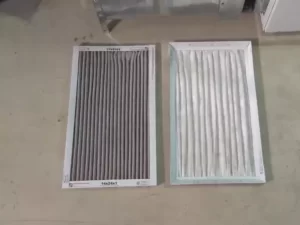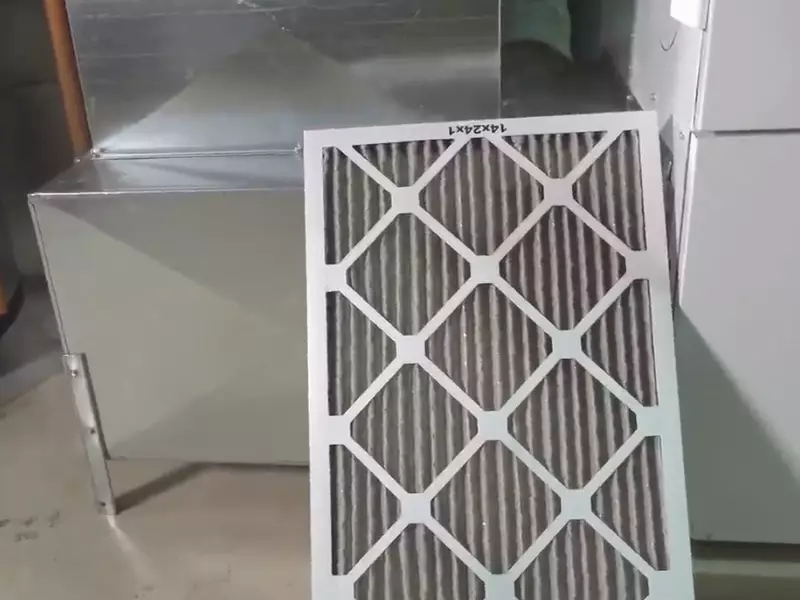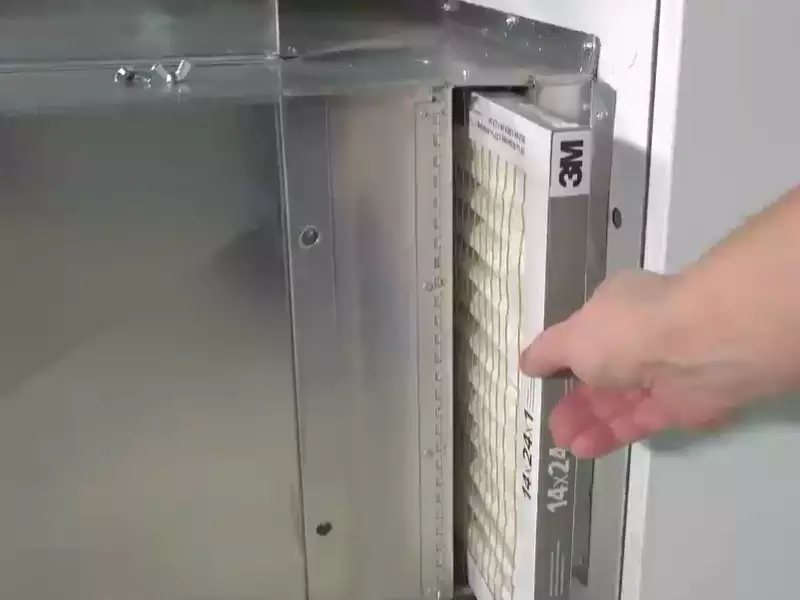To install an HVAC filter, locate the filter compartment, open it, remove the old filter, and insert the new one. If you want to ensure optimum air quality and improve the efficiency of your HVAC system, proper installation and maintenance of an HVAC filter are crucial.
A clean and properly installed filter helps to trap dust, allergens, and pollutants, preventing them from circulating in your home. Moreover, it can prolong the lifespan of your HVAC system and reduce energy consumption. We will explain how to install an HVAC filter correctly.
By following these simple steps, you will be able to replace the filter and enjoy cleaner, healthier air in your home. Let’s get started!
Importance Of A Clean And Functional HVAC Filter
Air Quality and Health Benefits
A clean and functional HVAC filter plays a crucial role in maintaining good indoor air quality, which is essential for promoting a healthy living environment. The air we breathe indoors can be up to five times more polluted than outdoor air, primarily due to pollutants such as dust, pollen, pet dander, mold spores, and even harmful chemicals released from cleaning products or building materials. When these contaminants circulate through your HVAC system, they can be dispersed throughout your home, leading to respiratory issues, allergies, asthma flare-ups, and other health problems.
By regularly changing and ensuring the cleanliness of your HVAC filter, you can significantly improve the air quality in your home. The filter acts as a barrier, capturing these harmful particles and preventing them from recirculating, thus reducing the risk of health issues caused by poor indoor air quality.

Increased Efficiency and Reduced Energy Consumption
Another key reason for maintaining a clean HVAC filter is to promote energy efficiency and reduce energy consumption. When your filter becomes dirty and clogged with contaminants, it restricts the airflow in your HVAC system, causing it to work harder to achieve the desired temperature. This increased workload not only puts strain on the system but also leads to higher energy consumption, resulting in inflated utility bills.
By regularly replacing your HVAC filter, you ensure optimal airflow and help your system operate more efficiently. When the filter is clean, air can flow freely, preventing the system from overworking and saving energy. This not only reduces your environmental footprint but also lowers your monthly energy expenses, providing both economic and environmental benefits.
In conclusion, maintaining a clean and functional HVAC filter is essential for both your health and the efficiency of your system. By paying attention to this often-overlooked component, you can promote better indoor air quality, safeguard your respiratory health, increase the lifespan of your HVAC system, and save money on energy costs.
Step-By-Step Guide To Installing A New Hvac Filter
Installing a new HVAC filter is an essential part of regular maintenance for your heating, ventilation, and air conditioning system. A clean and properly functioning filter helps to improve air quality in your home, increase the efficiency of your HVAC system, and extend its lifespan. In this step-by-step guide, we will walk you through the process of installing a new HVAC filter, from determining the right size and type to checking for proper airflow. Let’s get started!
Determine the filter size and type needed
The first step in installing a new HVAC filter is to determine the correct size and type. HVAC filters come in various sizes, such as 16x20x1 or 20x25x4, which represent the length, width, and thickness of the filter. To find the right size, you can refer to the owner’s manual of your HVAC system or check the size of the old filter that you are replacing. Additionally, consider the filter type based on your specific needs, such as fiberglass filters for basic filtration or high-efficiency filters for better particle capture.
Turn off the HVAC system and locate the filter compartment
Before replacing the filter, it is crucial to turn off the HVAC system to prevent any safety risks. Locate the filter compartment, which is typically found in the return air duct or near the air handler unit. The filter compartment may have a removable cover or grille that you need to unscrew or unlatch to access the filter.
Remove the old filter
Once you have accessed the filter compartment, carefully remove the old filter. Take note of the direction it was installed as some filters may have arrows indicating the proper airflow direction. If there is any visible dirt or debris on the old filter, it is a good idea to clean the area surrounding the filter compartment before proceeding.

Properly dispose of the old filter
Once the old filter has been removed, it is important to properly dispose of it. Since filters can collect dust, allergens, and other particles, it is recommended to seal the old filter in a plastic bag before discarding it to avoid releasing any contaminants back into the air. Check with your local waste management guidelines for the correct disposal method.
Insert the new filter
Now it’s time to insert the new filter into the filter compartment. Ensure that the filter is facing the correct direction, following the airflow arrows if present. Slowly slide the filter into place, ensuring a snug fit without forcing it. If the filter compartment has a track or grooves, align the filter accordingly for proper installation.
Ensure proper alignment and a snug fit
Double-check that the new filter is aligned correctly in the filter compartment and that it is securely in place. A loose or misaligned filter can result in air bypassing the filter, reducing its effectiveness. If necessary, adjust the filter positioning or the filter compartment cover to ensure a proper fit.
Turn on the HVAC system and check for proper airflow
Finally, once you have installed the new filter and secured the filter compartment, it’s time to turn on the HVAC system. Allow the system to run for a few minutes and check for proper airflow from the vents throughout your home. If you notice any issues with airflow, such as weak or uneven airflow, it may indicate a problem with the installation. In such cases, you may need to recheck the alignment and fit of the filter or consult a professional HVAC technician.
Congratulations, you have successfully completed the step-by-step guide to installing a new HVAC filter! By regularly replacing your HVAC filter, you can ensure better indoor air quality and maintain the efficiency of your HVAC system.
Tips And Best Practices For Installing Hvac Filters
When it comes to maintaining a properly functioning HVAC system, one of the most important steps is to install and replace HVAC filters regularly. This not only ensures clean and healthy air circulation but also enhances the efficiency and lifespan of your HVAC unit. In this blog post, we will dive into the tips and best practices for installing HVAC filters, covering everything from the frequency of filter replacement to choosing the right filter for your specific needs and maintaining a regular filter replacement schedule.

Frequency of filter replacement
Understanding how frequently you should replace your HVAC filters is crucial for maintaining indoor air quality and preventing system issues. While there is no one-size-fits-all answer, here are some general guidelines:
- For standard disposable filters, it is recommended to replace them every 1-3 months.
- If you have pets, live in a dusty environment, or suffer from allergies, you may need to replace the filters more frequently, such as every 2-4 weeks.
- Reusable filters require regular cleaning and should be replaced every 6-12 months, depending on the manufacturer’s instructions.
Choosing the right filter for your specific needs
When selecting an HVAC filter, it is essential to consider your specific needs, such as air quality concerns, allergies, and the HVAC system’s requirements. Here are some factors to consider:
- Filter size: Measure the dimensions of your existing filter or consult the HVAC system manual to ensure you purchase the correct size.
- Filter material: Filters come in various materials, including fiberglass, pleated, and electrostatic. Each material has its own benefits and filtration capabilities.
- MERV rating: Minimum Efficiency Reporting Value (MERV) determines the filter’s ability to capture particles. Higher MERV ratings indicate better filtration, but it’s important to ensure it aligns with your HVAC system’s specifications.
Considering filter ratings and MERV levels
Filter ratings and MERV levels play a significant role in the filtration efficiency. Here’s a breakdown of different MERV levels:
| MERV Level | Particle Size | Application |
|---|---|---|
| 1-4 | Larger particles (e.g., pollen, dust mites) | Residential, basic filtration |
| 5-8 | Small particles (e.g., pet dander, mold spores) | Residential, better filtration |
| 9-12 | Fine particles (e.g., bacteria, tobacco smoke) | Commercial spaces, hospitals |
| 13-16 | Ultrafine particles (e.g., some viruses, smoke) | Hospitals, advanced filtration needs |
Additional steps for reusable filters
For those using reusable filters, follow these steps to ensure proper installation and maintenance:
- Turn off the HVAC system and remove the filter from its housing.
- Carefully clean the filter using a vacuum or rinse it with water, depending on the manufacturer’s instructions.
- Allow the filter to dry completely before reinstalling it.
- Ensure the filter is properly positioned within the housing and securely fastened.
Maintaining a regular filter replacement schedule
Establishing a regular filter replacement schedule is vital for optimal HVAC system performance. Here are some tips:
- Set reminders: Use calendar alerts or smartphone apps to remind you when it’s time to replace or clean the filters.
- Buy filters in bulk: Invest in multiple filters to have them readily available for replacements.
- Keep a record: Maintain a log of filter replacements to track the frequency and ensure you stay on schedule.
By following these tips and best practices, you can ensure cleaner and healthier air while maximizing the efficiency and longevity of your HVAC system. Remember to consult the manufacturer’s instructions for any specific guidelines related to your HVAC unit and filters.
Frequently Asked Questions Of How To Install HVAC Filter
Which Way Does Air Filter Go?
Air filters should be installed with the arrows pointing in the direction of airflow. Check the arrow markings on the filter frame for the correct orientation. Always follow the manufacturer’s instructions for proper installation.
How Do You Install An Air Filter In An HVAC System?
To install an air filter in an HVAC system, follow these steps:
1. Locate the filter slot on the HVAC unit.
2. Turn off the system.
3. Open the filter slot and remove the old filter.
4. Insert the new filter, making sure it fits snugly.
5. Close the filter slot and switch the system back on. Regularly check and replace the filter to maintain efficiency.
Is There A Correct Way To Put In An Ac Filter?
Yes, there is a correct way to put in an AC filter. To do it properly, follow these steps: 1. Turn off your AC unit.
2. Locate the filter slot and open it.
3. Remove the old filter.
4. Insert the new filter, ensuring it fits properly.
5. Close the filter slot and turn on the AC unit.
Which Way Do I Put My Furnace Filter In?
To put your furnace filter in, locate the filter slot, remove the old filter, and then slide in the new filter with the arrow or airflow indicator pointing toward the furnace unit. Make sure to secure the filter in place and close the filter door.
Conclusion
Installing an HVAC filter is a simple task that can greatly improve the air quality in your home. By following these step-by-step instructions, you’ll be able to replace your old filter with ease. Remember to choose the right size and type of filter for your HVAC system, and to replace it regularly.
With a clean and efficient filter, you’ll enjoy better indoor air quality and maximize the efficiency of your HVAC system. Keep your home comfortable and healthy by maintaining your HVAC filter!
